Jean Martinet
HFGaussian: Learning Generalizable Gaussian Human with Integrated Human Features
Nov 05, 2024Abstract:Recent advancements in radiance field rendering show promising results in 3D scene representation, where Gaussian splatting-based techniques emerge as state-of-the-art due to their quality and efficiency. Gaussian splatting is widely used for various applications, including 3D human representation. However, previous 3D Gaussian splatting methods either use parametric body models as additional information or fail to provide any underlying structure, like human biomechanical features, which are essential for different applications. In this paper, we present a novel approach called HFGaussian that can estimate novel views and human features, such as the 3D skeleton, 3D key points, and dense pose, from sparse input images in real time at 25 FPS. The proposed method leverages generalizable Gaussian splatting technique to represent the human subject and its associated features, enabling efficient and generalizable reconstruction. By incorporating a pose regression network and the feature splatting technique with Gaussian splatting, HFGaussian demonstrates improved capabilities over existing 3D human methods, showcasing the potential of 3D human representations with integrated biomechanics. We thoroughly evaluate our HFGaussian method against the latest state-of-the-art techniques in human Gaussian splatting and pose estimation, demonstrating its real-time, state-of-the-art performance.
EvSegSNN: Neuromorphic Semantic Segmentation for Event Data
Jun 20, 2024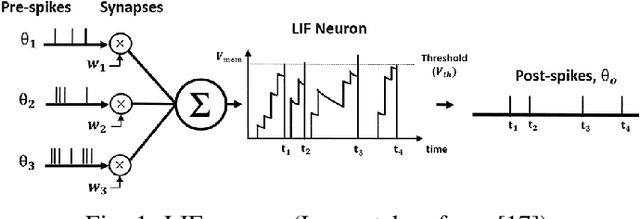
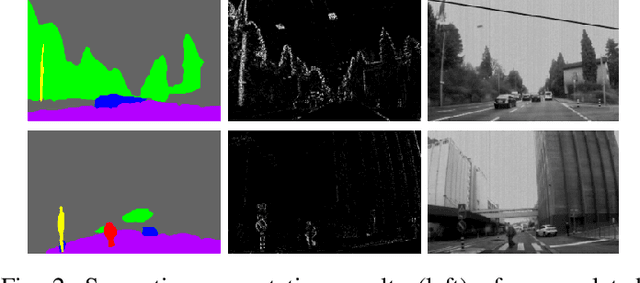
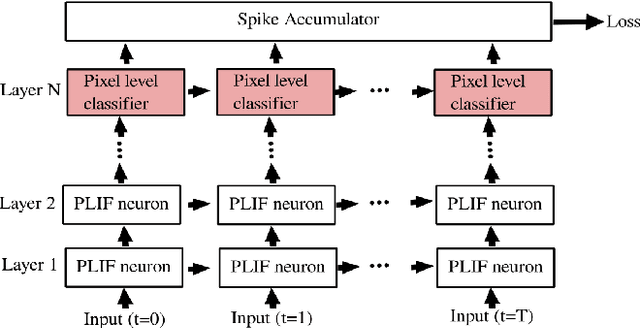
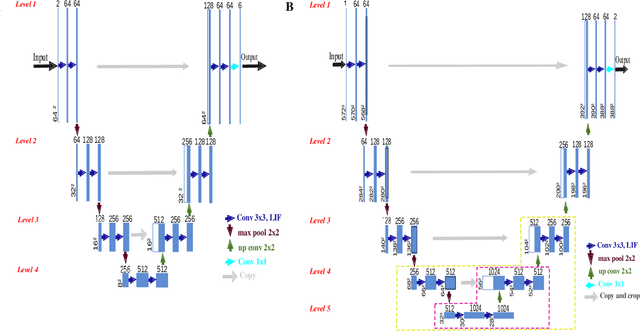
Abstract:Semantic segmentation is an important computer vision task, particularly for scene understanding and navigation of autonomous vehicles and UAVs. Several variations of deep neural network architectures have been designed to tackle this task. However, due to their huge computational costs and their high memory consumption, these models are not meant to be deployed on resource-constrained systems. To address this limitation, we introduce an end-to-end biologically inspired semantic segmentation approach by combining Spiking Neural Networks (SNNs, a low-power alternative to classical neural networks) with event cameras whose output data can directly feed these neural network inputs. We have designed EvSegSNN, a biologically plausible encoder-decoder U-shaped architecture relying on Parametric Leaky Integrate and Fire neurons in an objective to trade-off resource usage against performance. The experiments conducted on DDD17 demonstrate that EvSegSNN outperforms the closest state-of-the-art model in terms of MIoU while reducing the number of parameters by a factor of $1.6$ and sparing a batch normalization stage.
GHNeRF: Learning Generalizable Human Features with Efficient Neural Radiance Fields
Apr 09, 2024



Abstract:Recent advances in Neural Radiance Fields (NeRF) have demonstrated promising results in 3D scene representations, including 3D human representations. However, these representations often lack crucial information on the underlying human pose and structure, which is crucial for AR/VR applications and games. In this paper, we introduce a novel approach, termed GHNeRF, designed to address these limitations by learning 2D/3D joint locations of human subjects with NeRF representation. GHNeRF uses a pre-trained 2D encoder streamlined to extract essential human features from 2D images, which are then incorporated into the NeRF framework in order to encode human biomechanic features. This allows our network to simultaneously learn biomechanic features, such as joint locations, along with human geometry and texture. To assess the effectiveness of our method, we conduct a comprehensive comparison with state-of-the-art human NeRF techniques and joint estimation algorithms. Our results show that GHNeRF can achieve state-of-the-art results in near real-time.
HFNeRF: Learning Human Biomechanic Features with Neural Radiance Fields
Apr 09, 2024Abstract:In recent advancements in novel view synthesis, generalizable Neural Radiance Fields (NeRF) based methods applied to human subjects have shown remarkable results in generating novel views from few images. However, this generalization ability cannot capture the underlying structural features of the skeleton shared across all instances. Building upon this, we introduce HFNeRF: a novel generalizable human feature NeRF aimed at generating human biomechanic features using a pre-trained image encoder. While previous human NeRF methods have shown promising results in the generation of photorealistic virtual avatars, such methods lack underlying human structure or biomechanic features such as skeleton or joint information that are crucial for downstream applications including Augmented Reality (AR)/Virtual Reality (VR). HFNeRF leverages 2D pre-trained foundation models toward learning human features in 3D using neural rendering, and then volume rendering towards generating 2D feature maps. We evaluate HFNeRF in the skeleton estimation task by predicting heatmaps as features. The proposed method is fully differentiable, allowing to successfully learn color, geometry, and human skeleton in a simultaneous manner. This paper presents preliminary results of HFNeRF, illustrating its potential in generating realistic virtual avatars with biomechanic features using NeRF.
Bio-inspired visual attention for silicon retinas based on spiking neural networks applied to pattern classification
May 31, 2021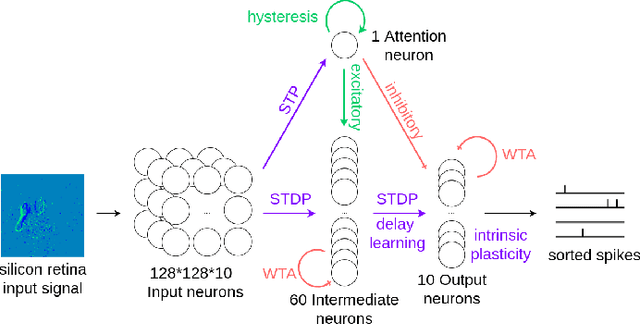


Abstract:Visual attention can be defined as the behavioral and cognitive process of selectively focusing on a discrete aspect of sensory cues while disregarding other perceivable information. This biological mechanism, more specifically saliency detection, has long been used in multimedia indexing to drive the analysis only on relevant parts of images or videos for further processing. The recent advent of silicon retinas (or event cameras -- sensors that measure pixel-wise changes in brightness and output asynchronous events accordingly) raises the question of how to adapt attention and saliency to the unconventional type of such sensors' output. Silicon retina aims to reproduce the biological retina behaviour. In that respect, they produce punctual events in time that can be construed as neural spikes and interpreted as such by a neural network. In particular, Spiking Neural Networks (SNNs) represent an asynchronous type of artificial neural network closer to biology than traditional artificial networks, mainly because they seek to mimic the dynamics of neural membrane and action potentials over time. SNNs receive and process information in the form of spike trains. Therefore, they make for a suitable candidate for the efficient processing and classification of incoming event patterns measured by silicon retinas. In this paper, we review the biological background behind the attentional mechanism, and introduce a case study of event videos classification with SNNs, using a biology-grounded low-level computational attention mechanism, with interesting preliminary results.
 Add to Chrome
Add to Chrome Add to Firefox
Add to Firefox Add to Edge
Add to Edge